Brazilian Air Force
| Brazilian Air Force Força Aérea Brasileira | |
|---|---|
|
Brazilian Air Force emblem | |
| Active | 20 January 1941 – present |
| Country |
|
| Type | Air force |
| Size |
77,454 personnel (2013) 627 aircraft |
| Part of | Ministry of Defence |
| Command headquarters | Brasília, Federal District, Brazil |
| Patron | Eduardo Gomes[1] |
| Motto(s) | "Wings that protect the country!" |
| March | Hino dos Aviadores |
| Anniversaries |
May 22 (anniversary) April 22 (fighter aviation day) |
| Engagements |
Contestado War (1912–16) Lieutenants Revolts (1922–27) Constitutionalist War (1932) World War II (1942–45) Lobster War (1961–63) Araguaia guerrilla (1966–74) Operation Traira (1991) |
| Commanders | |
| Commander-in-Chief | President Michel Temer |
| Commander |
|
| Insignia | |
| Fin flash |
 |
| Roundel |
 |
| Roundel (low visibility) |
 |
| Roundel (World War II) |
|
| Aircraft flown | |
| Attack | A-1M, A-29, AH-2 |
| Electronic warfare | R-99, E-99 |
| Fighter | Gripen NG (planned), F-5M |
| Interceptor | F-5M |
| Patrol | P-3AM, P-95 |
| Reconnaissance | R-95, RA-1M, R-35, RQ-450, RQ-900 |
| Trainer | AT-27, T-25, H-50 |
| Transport | C-767, KC-390(planned), C-98, C-130, C-105, H-34, H-1, C-95, C-99, H-60, H-36 |
The Brazilian Air Force (Portuguese: Força Aérea Brasileira, FAB) is the air branch of the Brazilian Armed Forces and one of the three national uniformed services. The FAB was formed when the Army and Navy air branch were merged into a single military force initially called "National Air Forces" in 1941. Both air branches transferred their equipment, installations and personnel to the new force.
According to the Flight International (Flightglobal.com) and the International Institute for Strategic Studies, the Brazilian Air Force has an active strength of 77,454 military personnel and operates around 627 aircraft.[2] The Brazilian Air Force is the largest air force in the Southern hemisphere and the second largest in the Americas after the United States Air Force.[3]
History
For a list of historic aircraft that has served with the Brazilian Armed Forces, see List of Brazilian military aircraft
Establishment
The establishment of the United Kingdom's Royal Air Force in April 1918, and the creation of the Italian Air Force (Regia Aeronautica) and the French Air Force during the 1920s drove the idea of uniting Brazilian air power under the same organization. Together with these events the Brazilian strategists were also influenced by the theories of Giulio Douhet, Billy Mitchell and Hugh Montague Trenchard.
The first public manifest[4] to create an integrated military air service came up in 1928 when an army Major called Lysias Rodrigues wrote an article called "An urgent need: The Ministry of the Air" ("Uma premente necessidade: o Ministério do Ar"). Two years later the French Military Mission, working for the Brazilian Army, made the first steps to organize a national air arm. The idea got more support when a group of Brazilian airmen came from Italy in 1934 and explained the advantages of having a military aviation unified. Also, the Spanish Revolution and the first movements of World War II at the end of the thirties showed the importance of Air power for military strategies.
One of the main supporters of the plan to create an independent air arm was the then-president Getúlio Vargas. He organized a study group early in 1940 and the whole structure of the Ministry of Aeronautics (Ministério da Aeronáutica) was established the end of that year. This new governmental agency was responsible for the all aspects of the civil and military aviation including infrastructure, regulation and organization.[5]
Formally, the Ministry of Aeronautics was founded on January 20, 1941 and so its military branch called "National Air Forces", changed to "Brazilian Air Force" (Força Aérea Brasileira – FAB) on May, 22. The Army ("Aviação Militar") and Navy ("Aviação Naval") air branches were extinguished and all personnel, aircraft, installations and other related equipment were transferred to FAB.[5]
World War II
The Brazilian Air force made important contributions to the Allied war effort in World War II, especially as part of the Brazilian Expeditionary Force on the Italian front.[6][7][8]
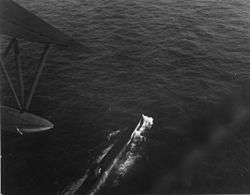
From mid-1942 until the end of the war, the FAB also patrolled the Atlantic. On 31 July 1943 it claimed the German submarine U-199, which was located on the surface, off Rio de Janeiro, at 23°54′S 42°54′W / 23.900°S 42.900°WCoordinates: 23°54′S 42°54′W / 23.900°S 42.900°W. Two Brazilian aircraft, a PBY Catalina and a Lockheed Hudson, and an American PBM Mariner attacked the U-boat.[9] The Catalina, named Ärará, was captained by 2º Ten.-Av. (2nd Lt.) Alberto M. Torres,[10] and hit U-199 with depth charges, sinking her. Forty-nine of the crew were killed, although twelve Germans managed to escape, including the captain. This was possible due to the Catalina’s crew, who threw a lifeboat to the survivors.
1º Grupo de Aviação de Caça (1º GAVCA; "1st Fighter Group"), which saw action in Italy, was formed on December 18, 1943. Its commanding Officer was Ten.-Cel.-Av. (Aviation Lieutenant Colonel) Nero Moura.
The group had 350 men, including 43 pilots. The group was divided into four flights: Red ("A"), Yellow ("B"), Blue ("C"), and Green ("D"). The CO of the group and some officers were not attached to any specific flight. Unlike the BEF's Army component, the 1º GAVCA had personnel who were experienced Brazilian Air Force pilots. One of them was Alberto M. Torres, who had piloted a PBY Catalina that had sunk U-199, operating off the Brazilian coast.
The group trained for combat in Panama, where 2º Ten.-Av. (Aviation Second Lieutenant) Dante Isidoro Gastaldoni was killed in a training accident. On May 11, 1944, the group was declared operational and became active in the air defense of the Panama Canal Zone. On June 22, the 1º GAVCA traveled to the US to convert to the Republic P-47D Thunderbolt.
On September 19, 1944 the 1º GAVCA left for Italy, arriving at Livorno on October 6. It became part of the 350th Fighter Group of the USAAF, which in turn was part of the 62nd Fighter Wing, XXII Tactical Air Command, of the 12th Air Force.
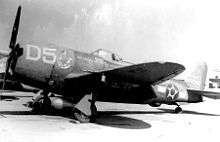
The Brazilian pilots initially flew from 31 October 1944, as individual elements of flights attached to 350th FG squadrons, at first in affiliation flights and progressively taking part in more dangerous missions. Less than two weeks later, on November 11, the group started its own operations flying from its base at Tarquinia, using its tactical callsign Jambock. Brazilian Air Force stars replaced the white U.S. star in the roundel on the FAB Thunderbolts. The 1oGAVCA started its fighting career as a fighter-bomber unit, its missions being armed reconnaissance and interdiction, in support of the US Fifth Army, to which the FEB was attached.

On April 16, 1945, the U.S. Fifth Army started its offensive along the Po Valley. By then, the strength of the Group had fallen to 25 pilots, some having been killed and others shot down and captured. Some others had been relieved from operations on medical grounds due to combat fatigue. The Group disbanded the Yellow flight and distributed the surviving pilots among the other flights. Each pilot flew on average two missions a day.
On 22 April 1945, the three remaining flights took off at 5-minute intervals, starting at 8:30 AM, to destroy bridges, barges, and motorized vehicles in the San Benedetto region. At 10:00 AM, a flight took off for an armed reconnaissance mission south of Mantua. They destroyed more than 80 tanks, trucks, and vehicles. By the end of the day, the group had flown 44 individual missions and destroyed hundreds of vehicles and barges. On this day the group flew the most sorties of the war; consequently, Brazil commemorates April 22 Brazilian Fighter Arm Day.
In all, the 1oGAVCA flew a total of 445 missions, 2,550 individual sorties, and 5,465 combat flight hours, from 11 November 1944 to 6 May 1945. The XXII Tactical Air Command acknowledged the efficiency of the Group by noting that although it flew only 5% of the total of missions carried out by all squadrons under its control, it accomplished a much higher percentage of the total destruction wrought:
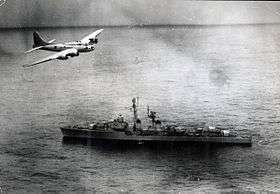
- 85% of the ammunition depots
- 36% of the fuel depots
- 28% of the bridges (19% damaged)
- 15% of motor vehicles (13% damaged)
- 10% of horse-drawn vehicles (10% damaged)[11]
Post World War II
_RSC.jpg)
After the war, the FAB began flying the British Gloster Meteor jet fighter. The jets were purchased from the British for 15,000 tons of crude cotton, as Brazil had no foreign currency reserves to spare. The jet was operated by the FAB until the mid-1960s, when it was replaced by the F-80C and TF-33A, which were later replaced by the MB-326, Mirage III and Northrop F-5 jets.
Having been given authority over all national military aircraft since 1941, from her commissioning in 1961 to 1999 the Brazilian Air Force flew the S-2 Trackers of the aircraft carrier Minas Gerais while from 1965 naval aviation flew its own helicopters. Now naval aviation is also authorized to fly its own fixed wing carrier based aircraft.
Cold War
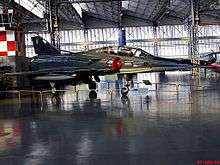
During the Cold War, the then Brazilian Dictatorship was aligned with the United States and NATO. This meant that the F-5 could be bought cheaply from the United States, who called this jet the "Freedom Fighter". Many other countries, such as Mexico, also benefited from this policy.
The Embraer (Empresa Brasileira de Aeronáutica, Brazilian Aeronautic Co.) has its origins as an enterprise directly managed and sponsored by the FAB. Working with Italian corporations, it developed the new AMX attack aircraft (known locally as A-1) which makes up the backbone of the FAB's attack force. The successful Tucano T-27 trainer and the new light attack aircraft A-29 are also Embraer aircraft used extensively by the FAB.
During Traira operation, in February 1991, six Tucanos were used for close air support against a group of 40 rebels from the Revolutionary Armed Forces of Colombia (Fuerzas Armadas Revolucionarias de Colombia, FARC), which had seized a Brazilian military detachment.
Brazilian Air Force today
Air defence and strike aircraft
.jpg) F-5EM Tiger II fighter jet.
F-5EM Tiger II fighter jet.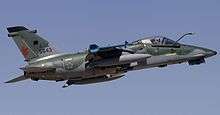 AMX A-1A ground-attack.
AMX A-1A ground-attack._Lofting.jpg) A-27 Tucano, light patrol and close air support.
A-27 Tucano, light patrol and close air support..jpg) A-29 Super Tucano, close air support.
A-29 Super Tucano, close air support.
Airborne early warning, reconnaissance aircraft and maritime patrol
.jpg) Embraer E-99 airborne early warning and control.
Embraer E-99 airborne early warning and control..jpg) P-95A Bandeirulha maritime patrol.
P-95A Bandeirulha maritime patrol..jpg)
_(8101398607).jpg)
- Embraer R-99B remote sensing
%2C_Brazil_-_Air_Force_AN1401695.jpg) Hawker 800 Signals intelligence
Hawker 800 Signals intelligence
Transport and air-to-air refuelling aircraft
.jpg) Embraer C-95M military transport.
Embraer C-95M military transport.%2C_Brazil_-_Air_Force_AN1976288.jpg) EADS/CASA C-295M military transport.
EADS/CASA C-295M military transport..jpg) C-130 tactical transport.
C-130 tactical transport. Embraer EMB-120 military transport.
Embraer EMB-120 military transport._Republica_Federativa_Do_Brasil_(12674772025).jpg) Airbus A319 VC-1A, The main presidential aircraft currently used to transport the President of Brazil.
Airbus A319 VC-1A, The main presidential aircraft currently used to transport the President of Brazil.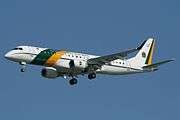 The VC-2 airplane used for short-range travel.
The VC-2 airplane used for short-range travel..jpg) Boeing KC-767, It has the refueling function in flight.
Boeing KC-767, It has the refueling function in flight.
Trainer aircraft
%2C_Brazil_-_Air_Force_AN1132356.jpg) T-25 Neiva Universal basic trainer.
T-25 Neiva Universal basic trainer._Forca_Aerea_Brasileira_(8169740328).jpg) T-27 Tucano basic trainer.
T-27 Tucano basic trainer.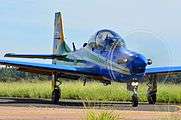 AT-29 Super Tucano trainer
AT-29 Super Tucano trainer
Helicopters
.jpg)
.jpg) Black Hawk, Utility helicopter.
Black Hawk, Utility helicopter..jpg) AS-332 Super Puma transport helicopter.
AS-332 Super Puma transport helicopter..jpg)
.jpg) Mil Mi-35M, Attack helicopter and patrol.
Mil Mi-35M, Attack helicopter and patrol.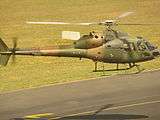 AS355, utility and liaison
AS355, utility and liaison%2C_Brazil_-_Air_Force_AN1133070.jpg) Eurocopter AS350 Écureuil, utility and trainer
Eurocopter AS350 Écureuil, utility and trainer
Future aircraft
.jpg) Saab JAS 39 Gripen future Brazilian multirole fighter.
Saab JAS 39 Gripen future Brazilian multirole fighter..jpg) Embraer KC-390 future Brazilian tactical transport.
Embraer KC-390 future Brazilian tactical transport..jpg) Embraer Legacy 500 future Brazilian signals intelligence.
Embraer Legacy 500 future Brazilian signals intelligence.
Developments
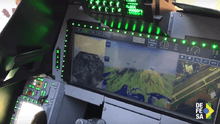
In the early 2000s, with renewed economic stability, the FAB underwent an extensive renewal of its inventory through several acquisition programs, the most ambitious of which was the acquisition of 36 new front-line interceptor aircraft to replace its aging Mirage III. Known in the late 1990s as the F-X Project, the program was postponed during the presidential mandate of Fernando Henrique Cardoso, who in the end of 2002 left the decision for his successor Luís Inácio ‘Lula’ da Silva, who postponed it again in 2003 and 2004.[12] It was postponed indefinitely in 2005.
On July 15, 2005 one agreement was set with the French government for the transfer of twelve Dassault Mirage 2000s (ten "C" and two "B" versions) second-hand ex-Armée de L'Air. Known as F-2000s in Brazil, the first two aircraft arrived at Anápolis Air Base on September 4, 2006.

In 2007, Brazilian Air Force's Institute for Advanced Studies started the 14-X development, a hypersonic scramjet demonstrator envisaged to fly at 30 km of altitude at 3 km/s, corresponding to Mach number 10. In March 2012 a Mach 7 variation has been suggested, named as 14-X S.[13]
On November 4, 2007 the F-X Project was restarted.[14] Known as Project F-X2 from the start of 2008, and with a bigger budget, the competitors for acquisition were the Eurofighter Typhoon, Sukhoi Su-35, Gripen NG, Dassault Rafale, Boeing F/A-18E/F Super Hornet and, although information on Lockheed Martin's F-35 Lightning II was requested, Lockheed Martin presented an F-16 Fighting Falcon variant (designated F-16BR).[15] In October 2008, FAB released a shortlist of 3 aircraft: Saab Gripen NG, Dassault Rafale and Boeing F/A-18E/F Super Hornet. In February 2009, the three companies provided their final bids.[16] In September 2009, following a surprise French visit to Brazil, Brazilian President Luiz Inácio Lula da Silva and Nicolas Sarkozy, from France, made a new military cooperation agreement. Lula, on an interview at TV5 Monde, said French Rafale was a step forward, as technology transfer would be effective.[17]
On September 7, 2009, Brazilian Independence Day, it was announced Brazil would negotiate 36 Dassault Rafale.[18] But the Defence Minister did not confirm the final decision.
.jpg)
On January 5, 2010, after lobbying by Air Force Officers and Commanders, it was reported that the final evaluation report by the Brazilian Air Force placed the Saab Gripen NG ahead of the other contenders. The decisive factor was apparently the overall cost of the new fighters, both in terms of unit cost, and operating and maintenance costs, and the personal preference of the test pilots. Rafale was reported to not even be the second choice.[19] It was announced in February 2011 that the decision would be further delayed due to budget cuts.[20] And that July the decision was put off for yet another six-month extension.[21]
However, in 2013, yet another six-month delay was announced.[22] In early June 2013, after a visit from US Vice President Joe Biden with Brazilian President Dilma Rouseff; Biden assured President Rouseff that the US Congress would approve technology transfer for Boeing's F-18s.[23][24] In a move apparently following the NSA spying scandal,[25][26] Russia has also offered Brazil a stake in the development of the Sukhoi PAK-FA 5th generation jet fighter[27] with complete stealth technology transfer.[28]
Saab won the competition on 18 December 2013.[29][30] The change away from the American jet was due to the 2013 Global surveillance disclosure, according to Reuters reporting;[31] other sources agree with the official rationale that the decision was due to cost and technological transfer.[32] As of January 2014, Brazil is in negotiations with Saab to lease current model Gripens while they wait four years for the next generation jets on order to be developed and built.[33]
On July 28, 2015, the Brazilian government met with a Swedish trading commission to revisit the contract and request a low of 2.58% in interest rates to 1.98% per annum, generating a savings of 1 billion dollars in 25 years. Sweden rejected the application and signing the contract is seriously threatened with limit until October 2015.[34]
On July 29, 2015, the Brazilian government confirms that it has reached an agreement with Sweden to finance the purchase of a batch of 36 Gripen NG. The contract should be signed in the coming days. The negotiations are part of the FX project to renew the country's air force.[35]
Command structure
.jpg)
The Brazilian Air Force is the aerospace branch of the Brazilian armed forces and is managed by the "Aeronautics Command" (Comando da Aeronáutica – COMAer). The COMAer was created in 1999[36] and replaced the Ministry of Aeronautics. Now, the COMAer is one of the three armed forces assigned to the Ministry of Defense (Ministério da Defesa).
The COMAer is led by the "Aeronautics Commander" (Comandante da Aeronáutica). The Commander is a "Tenente-Brigadeiro-do-Ar" (the most senior Air Force rank), is appointed by the President, and reports directly to the Minister of Defense.
COMAer comprises six major components, four "General Commands" (Comandos-Gerais) and two "Departaments" (Departamentos). The "General Command of Air Operations" (Comando-Geral de Operações Aéreas – COMGAR), with headquarters in Brasília, supervises most of the flying operations. As the main flying element, COMGAR administers several sub-formations in the form of four "Air Forces" (Forças Aéreas) and seven "Regional Air Commands" (Comandos Aéreos Regionais – COMAR).
Besides COMGAR, other major parallel organizations, which also report directly to the COMAer, are the "General Command of Support" (Comando-Geral de Apoio – COMGAP), "General Command of Personnel" (Comando-Geral de Pessoal – COMGEP), "General Command of Aerospatial Technology" (Comando-Geral de Tecnologia Aeroespacial – CTA), "Aeronautics Departament of Teaching" (Departamento de Ensino da Aeronáutica – DEPENS), "Departament of Civil Aviation" (Departamento de Aviação Civil – DAC) and "Departament of Airspace Control" (Departamento de Controle do Espaço Aéreo – DECEA).
Operations
.jpg)
A recent operation of the FAB was the bombing of illegal landing sites in the Amazon Forest, used by drug dealers to transport drugs into and out of Brazil (see SIVAM). The operation also had support from the Brazilian Army and Brazilian Federal Police with many drug dealers being arrested as a result. The AMX Bomber/Fighter was the primary plane used.
The FAB is currently working on the United Nations Stabilization Mission in Haiti (MINUSTAH) supporting the United Nations force (a joint Brazilian, Uruguayan, Chilean and Argentine force) deployed there.
In 2010, the FAB worked on the Search & Rescue mission of Air France Flight 447. The Brazilian Air Force has started a search and rescue from the Brazilian archipelago of Fernando de Noronha, sending eight planes to search a stretch bounded by the coastal cities of Recife, Natal and the archipelago of Fernando de Noronha.
_faz_treinamento_de_intercepta%C3%A7%C3%A3o_a%C3%A9rea_para_os_Jogos_Ol%C3%ADmpicos_de_2016.jpg)
In 2011–2013, Operation Agatha marks the start of a new decade of the twenty-first century with the consolidation of the Amazon Surveillance System (SIVAM), an intricate network of radars, meteorological sensors, digital satellite communications, and advanced air-traffic-control software, among other technological advances available to Brazilian Military personnel. The Brazilian Air Force (FAB), which deployed new tactics and methods of fighting using RQ-450 remote-controlled aircraft. Operating in conjunction with sophisticated E-99 Guardian planes, they will locate objectives for A-29 Super Tucano fighters flying in darkness. Northrop F-5EM fighters, responsible for providing air superiority.
In July 2016, Defense Aerospace Brazilian command displays participation of Brazilian Air Force at the Olympics Games Rio 2016, there will be over 15,000 military and 80 aircraft involved in the Olympics. To defense missions and aerial patrol 32 fighters (Northrop F-5M and A-29 Super Tucano), for aerial warning missions 2 radar aircraft (Embraer R-99), surveillance missions 3 Unmanned aircraft (Hermes 450 and Hermes 900), for maritime patrol missions 1 (P-3 Orion), for logistical support missions (Boeing C-767, C-130 and C-295), 15 helicopters (Mil Mi-35, UH-60 Black Hawk and EC-725).[37]
Exercises
The Cruzex air force exercises are the most important of its type in South America. They are hosted every 2 years by the Brazilian Air Force. Issues and participants:
- Cruzex I 2002: South Region –
 ,
, ,
, ,
, – participation of 90 aircraft
– participation of 90 aircraft - Cruzex II 2004: Northeast Region –
 ,
, ,
, ,
, – participation of 92 aircraft
– participation of 92 aircraft - Cruzex III 2006: Central-West Region –
 ,
, ,
, ,
, ,
, ,
, – participation of 104 aircraft
– participation of 104 aircraft - Cruzex IV 2008: Northeast Region –
 ,
, ,
, ,
, ,
, – participation of 100 aircraft
– participation of 100 aircraft - Cruzex V 2010: Northeast Region –
 ,
, ,
, ,
, ,
, – participation of 97 aircraft
– participation of 97 aircraft - Cruzex VI 2012: Northeast Region –
 ,
, ,
, ,
, ,
, ,
, ,
, ,
, ,
, ,
, ,
, ,
, – personnel only, no aircraft
– personnel only, no aircraft - Cruzex Flight 2013: Northeast Region -
 ,
, ,
, ,
, ,
, ,
, ,
, ,
, – participation of 96 aircraft
– participation of 96 aircraft
Air units organization
At unit levels, "Groups" (Grupos) usually consist of one to sixteen consecutively numbered "Squadrons" (Esquadrões), each with varying numbers of aircraft, usually from six to 12. Smaller formations are known as "Flights" (Esquadrilhas). According to its tasks, a group has one of the following designations:
- Air Defense Group: Grupo de Defesa Aérea (GDA): Air defense fighters. (Fighter Jets)
- Transport Group: Grupo de Transporte (GT): Transport, Flight refueling
- Aviation Group: Grupo de Aviação (GAv): Fighter, attack, reconnaissance, SAR, rotary wing
- Fighter Aviation Group: Grupo de Aviação de Caça (GAvCa); Fighter, attack planes
- Troop Transport Group: Grupo de Transporte de Tropas (GTT): Transports, troop carrying, parachutist drop
- Special Flight Inspection Group: Grupo Especial de Inspeção em Vôo (GEIV): Calibration
- Special Test Flights Group: Grupo Especial de Ensaios de Vôo (GEEV): Test flights
- Special Transport Group: Grupo de Transporte Especial (GTE): VIP transport
Common used designations for squadrons are:
- Air Transport Squadron: Esquadrão de Transporte Aéreo (ETA)
- Air Training Squadron: Esquadrão de Instrução Aérea (EIA)
- Demonstration flying team: Esquadrão de Demonstração Aérea (EDA) (also called "Esquadrilha da Fumaça")
The Air Bases of the Brazilian Air Force are:
Inventory
Aircraft
Weapons
See also
- Academia da Força Aérea
- Aerial Demonstration Squadron
- Alberto Torres
- Brazil and weapons of mass destruction
- Brazilian Army
- Brazilian Army Aviation Command
- Brazilian Naval Aviation
- Brazilian Navy
- Military history of Brazil
- Military ranks of Brazil
- Rui Moreira Lima
References
- 1 2 Personalidades [Personalities] (in Portuguese), Força aérea brasileira.
- ↑ World Air Force 2014 – Flight International, Flightglobal.com, Accessed 23 November 2014
- ↑ "The Best Little Air Force You're Barely Aware Of". War Is Boring. 24 January 2014. Retrieved 11 August 2016.
- ↑ "1", História Geral da Aeronáutica [General History of Aeronautics] (in Portuguese), 3, Incaer, 1991.
- 1 2 Ad luna [To the Moon], BR: Universo online.
- ↑ FAB, Guerra Mundial [Brazilian Air Force, World War] (PDF) (opuscule) (in Portuguese), Força aérea brasileira.
- ↑ II guerra [World War] (in Portuguese), BR.
- ↑ P Brasil [P Brazil] (in Portuguese), Word press, 2009-08-23.
- ↑ "The Type IXD2 boat U-199". German U-boats of WWII. UBoat. Retrieved 9 March 2010.
- ↑ Morison, Samuel Eliot (March 2001). History of United States Naval Operations in World War II. 10: The Atlantic Battle Won. Castle Books. p. 219. ISBN 0-7858-1311-X.
- ↑ Buyers, John W, História dos 350th Fighter Group da Força Aérea Americana [History of the USAF 350th Fighter Group] (in Portuguese).
- ↑ "F‐X BR 2001–4", Global security.
- ↑ Carinhana Junior, Dermeval; Dacal, Luis Carlos Ogando; de Carvalho, Thiago Mendes (2015). "Atividades de Pesquisa e Desenvolvimento" (PDF). Workshop Anual de Pesquisa e Desenvolvimento do IEAv. Instituto de Estudos Avançados (Brazilian Air Force's Institute for Advanced Studies). 8: 73. ISSN 1983-1544. Retrieved 17 August 2016.
- ↑ "F‐X BR", Global security.
- ↑ "Brazil Offered F-16s, Not F-35s", Aviation Week.
- ↑ "Brazilian fighter programme ready to fly", Flight International, Flight global, 3 April 2009.
- ↑ "Negociações para compra de caça francês estão 'muito avançadas', diz Lula" [Negotiations for fighter acquisition are ‘very developed’, says ‘Lula’], G1 (in Portuguese), Globo, 2009-09-06.
- ↑ Guerreiro, Gabriela (2009-09-07), "Brasil confirma accordo para compra aviões militares da França" [Brazil confirms agreement to acquire military airplanes from France], Folha de S.Paulo (in Portuguese), Brasília, DF, BR: Universo online.
- ↑ Gripen favorit i Brasilien [Gripen favourite with Brazilians] (in Swedish), DNS.
- ↑ "Brazilian president confirms new slip to F-X2 fighter decision". Flight global. 2011-02-23. Retrieved 2011-03-08.
- ↑ "Brazil jet bid extended 6 months", Space daily, AFP, 7 July 2012.
- ↑ "Brazil likely won't have new jets for World Cup", Reuters, 2013-03-08.
- ↑ Winter, Brian (4 June 2013). "Brazil closer to Boeing on jets deal after Biden visit". Thomson Reuters. Retrieved 18 December 2013.
- ↑ "Brazil aims to build advanced fighter jets with Russia". Defence talk. October 16, 2013.
- ↑ "Brazil may reject US fighter jet deal over NSA spying scandal", RT, 2013-08-13.
- ↑ Mallén, Patricia Rey (September 12, 2013), "Boeing Might Lose $4B Brazil Deal For F-18 Jets After NSA Surveillance Scandal; Analysts Say Politics Won't Trump Business", International Business Times.
- ↑ "Russia to offer Brazil a stake in future advanced fighter project", RIA Novosti, 2013-10-14.
- ↑ "Russia offers PAK‐FA T‐50 to Brazil", Defence aviation, Oct 2013.
- ↑ "Brazil to award fighter jet deal to Saab", Reuters, 2013-12-18.
- ↑ "Saab Gripen NG wins Brazil jet fighter F-X2 competition and outbid Dassault Rafale and Boeing F-18". Air recognition. December 18, 2013.
- ↑ Winter, Brian (20 December 2013). "Insight: How US spying cost Boeing multibillion-dollar jet contract". Reuters. Thomson Reuters. Retrieved 20 December 2013.
- ↑ Aboulafia, Richard (2013-12-19), Brazil's Fighter Buy: That NSA Narrative Is Probably Wrong, Forbes,
There’s a chance the NSA scandal played a role in Brazil’s decision. But it’s just as likely that this decision was an honest reflection of Brazilian Air Force (BAF) requirements, and a realistic appraisal of the options on offer. […] In short, the NSA scandal was probably a completely marginal factor in Brazil’s fighter decision. But for Brazil’s politicians and some of its media, the FX-2 decision provides a convenient rationale for criticizing the US.
- ↑ Haynes, Brad; Oatis, Jonathan (21 December 2013). "Brazil may wait over four years for new fighters, says Saab". Reuters. Thomson Reuters. Retrieved 21 December 2013.
- ↑ "Suécia rejeita rever juros de contrato de compra dos caças Gripen NG do Brasil". Poder Aéreo. Alexandre Galante. 28 July 2015. Retrieved 29 July 2015.
- ↑ "Brasil fecha acordo com Suécia para financiamento de caças da Saab". Reuters. Anthony Boadle. 29 July 2015. Retrieved 29 July 2015.
- ↑ Lei complementar [Complementar law] (in Portuguese) (97), BR: Presidency, 9 June 1999.
- ↑ "Força Aérea Brasileira". fab.mil.br. Retrieved 11 August 2016.
Bibliography
- Hackett, James, ed. (2010-02-03), The Military Balance, London: International Institute for Strategic Studies, Routledge, ISBN 1-85743-557-5
External links
| Wikimedia Commons has media related to Air force of Brazil. |
- Brazilian Air Force website (Portuguese)
- Brazilian Air Force page at Scramble
- History of Brazilian Air Force in World War II (Portuguese)
- History of the Brazilian Air Force
- Milavia – Brazilian Air Force
- Military orders and medals from Brazil (Portuguese)

.jpg)
.jpg)